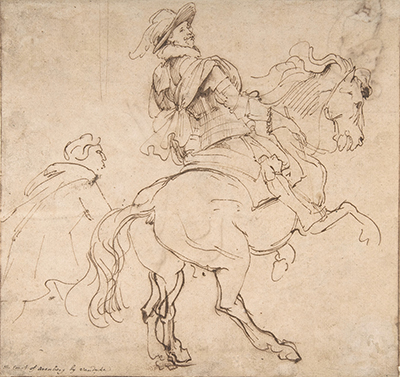This portrait study is amongst the finest pen and ink works by Van Dyck of all those still in existence
The precise date of this drawing is unclear, with some dating it at around 1620, when the artist was working closely with fellow master, Peter Paul Rubens. There is also some evidence that places it around a decade later, and no decisive choice either way has ever been made.
The artwork is almost square, measuring 24.5cm by 23cm. It is most likely that this paper was part of a small sketchbook as several other of his drawings are also of the same dimensions. To have a small paper pad would be ideal for the more spontaneous artist who might wish to begin a sketch on a sudden whim.
Most evidence suggests that this is a portrait of Van Dyck's main patron of the time, George Villiers, Duke of Buckingham. It probably would have been one of a series of study drawings in preparation for a final oil painting, but that was never completed. The reasons for this are unknown, perhaps the Duke later bulked at the expense of another commission, or instead chose to direct Van Dyck's talents in a different direction.
This artwork was gifted to the Metropolitan Museum of Art in New York by Harold K. Hochschild in 1940. The drawings of Van Dyck are spread right across Europe, with a few such as this to be found in the US. The equestrian form required considerable practice and this artist produced several paintings with horses during his career. Sketch work to study the shape and contours of this animal was absolutely necessary in order to continue his high standards achieved with human facial features.
The structure of the artist's portraits can be seen in its rawest form through the medium of drawing, making it an intriguing and informative medium. In recent centuries there has been a greater interest in the sketchwork of the great masters, leading to multiple exhibitions featuring solely this medium.
The famous flemish painters of around the Northern Renaissance and Baroque periods were often respected draughtsmen too. Rubens and Van Dyck would famously collaborate together whilst the others required the ability to draw their initial composition accurately before adding oils. Skills in this medium could also help save time by providing a starting point from where studio members could complete the less challenging elements of a larger project.
Amongst the finest examples in this medium of approximately this period would include Jan van Eyck drawings as well as those of the likes of Titian, Pieter Bruegel, Rembrandt and Bosch.




